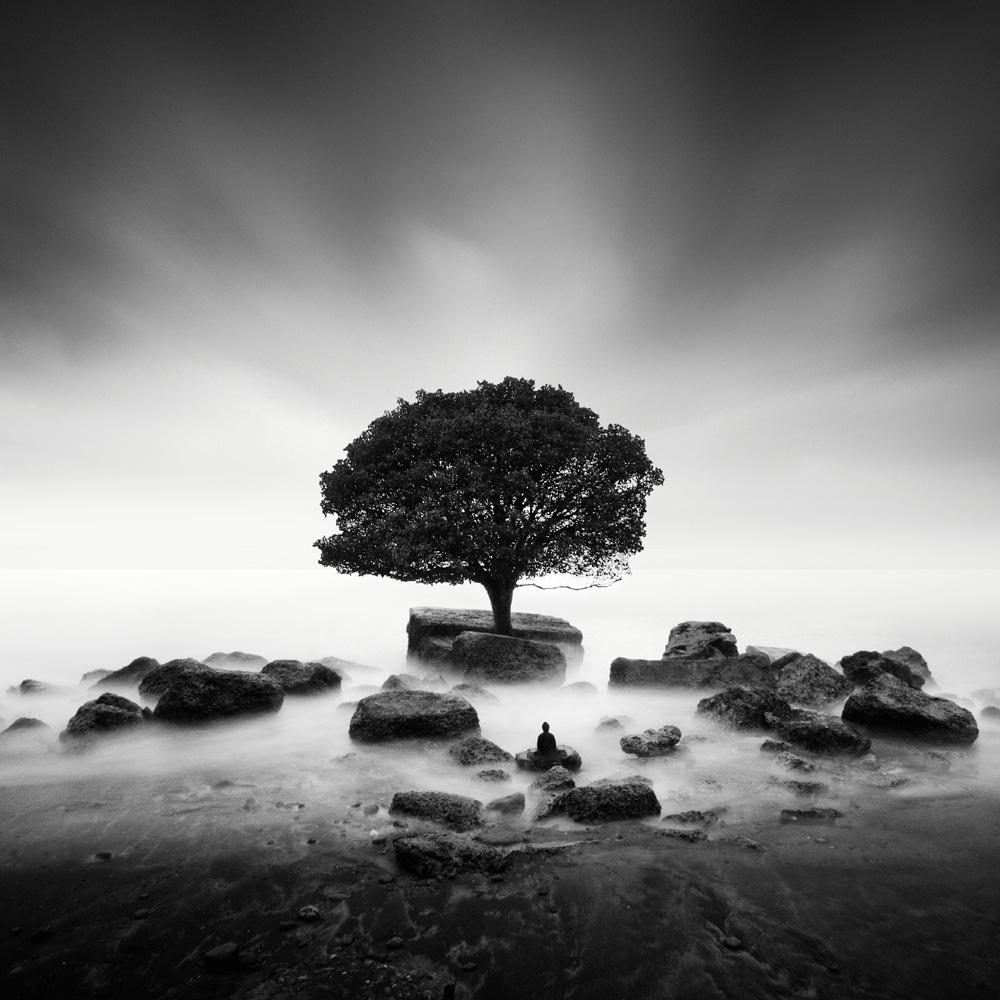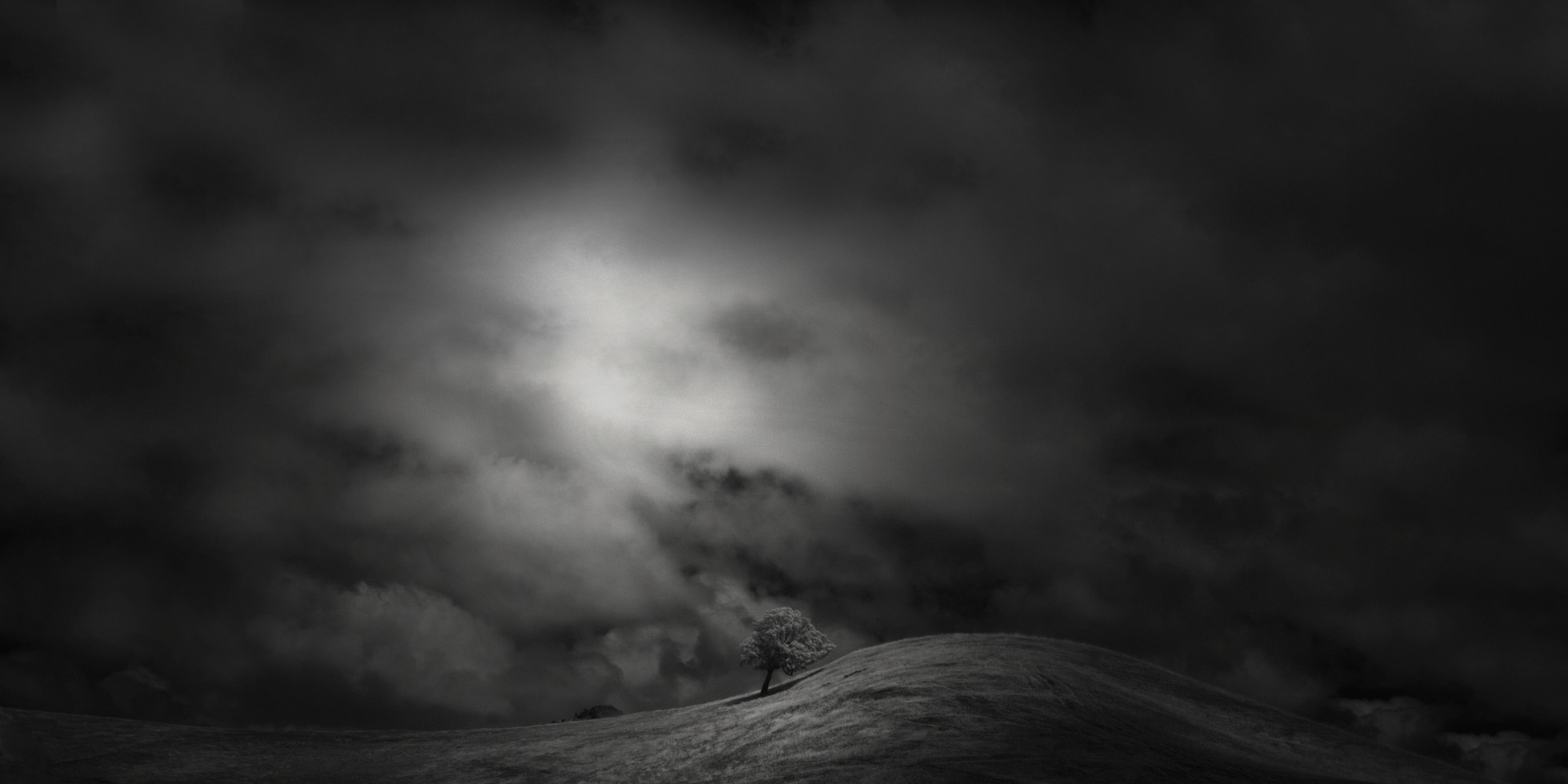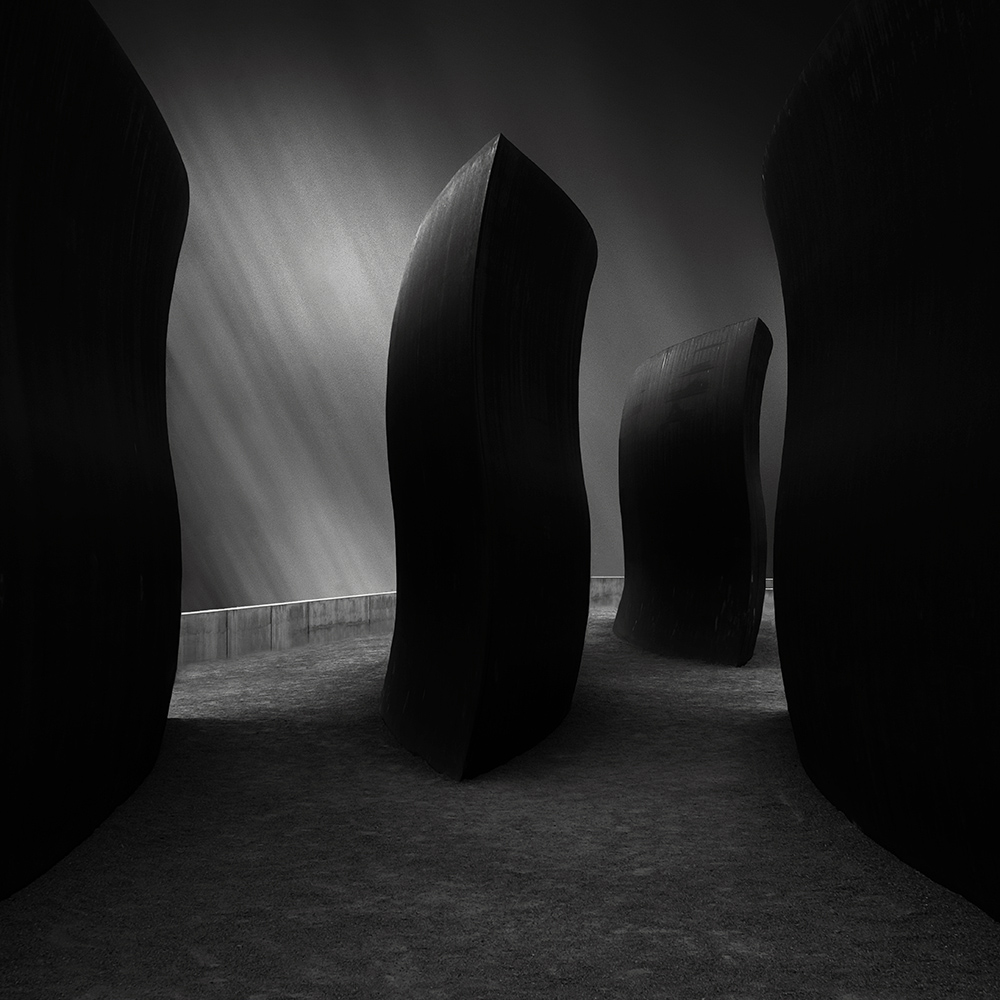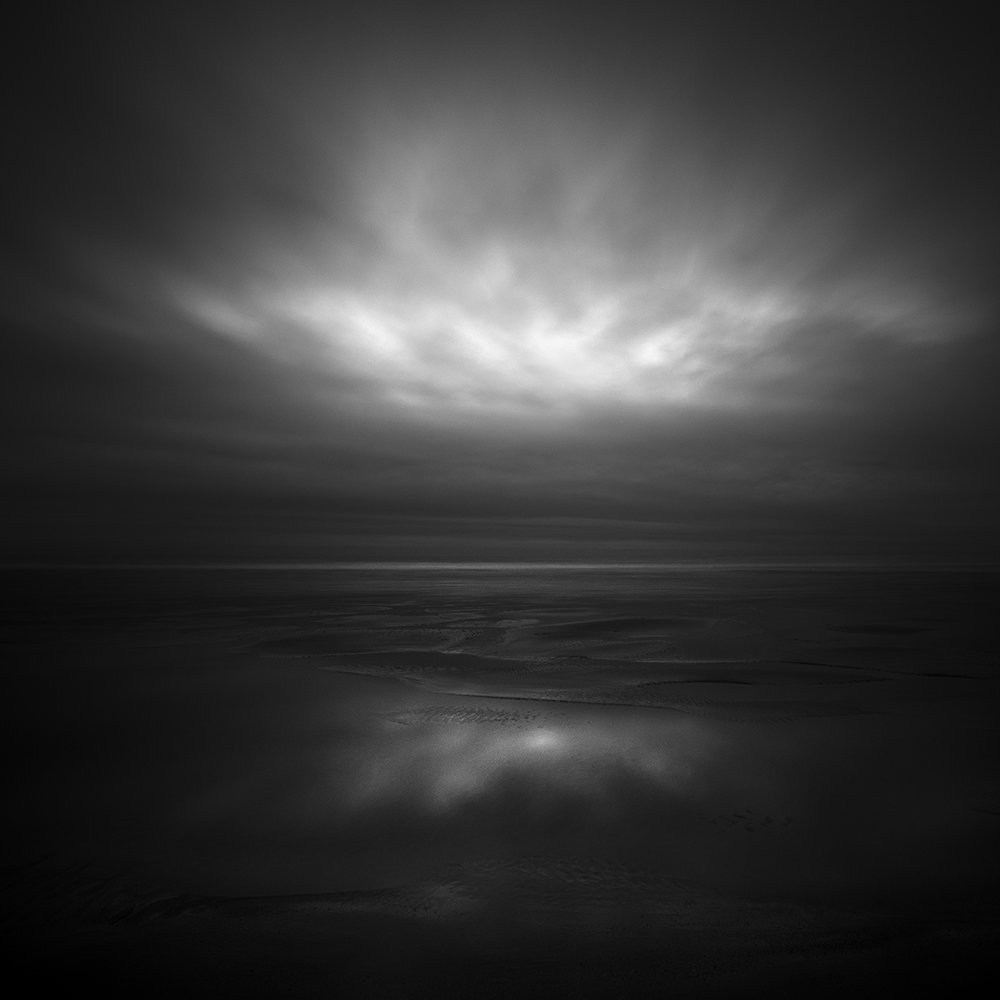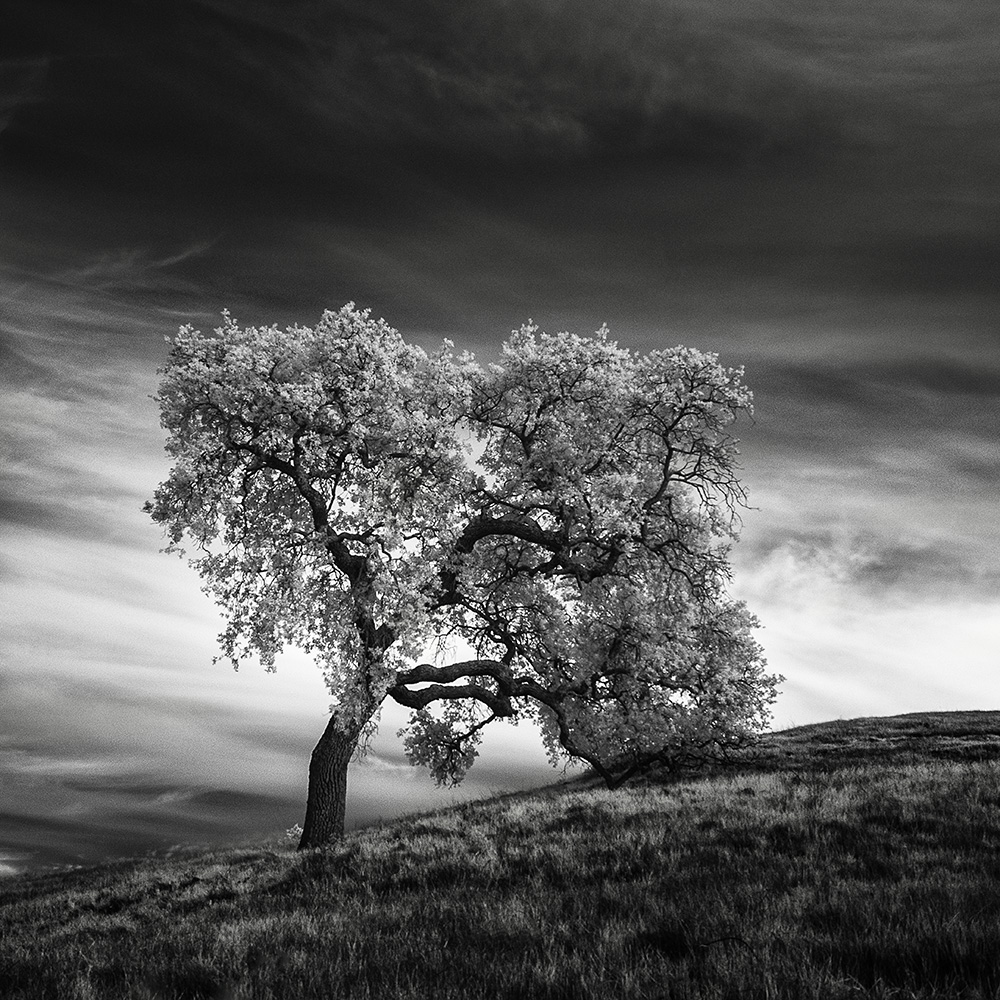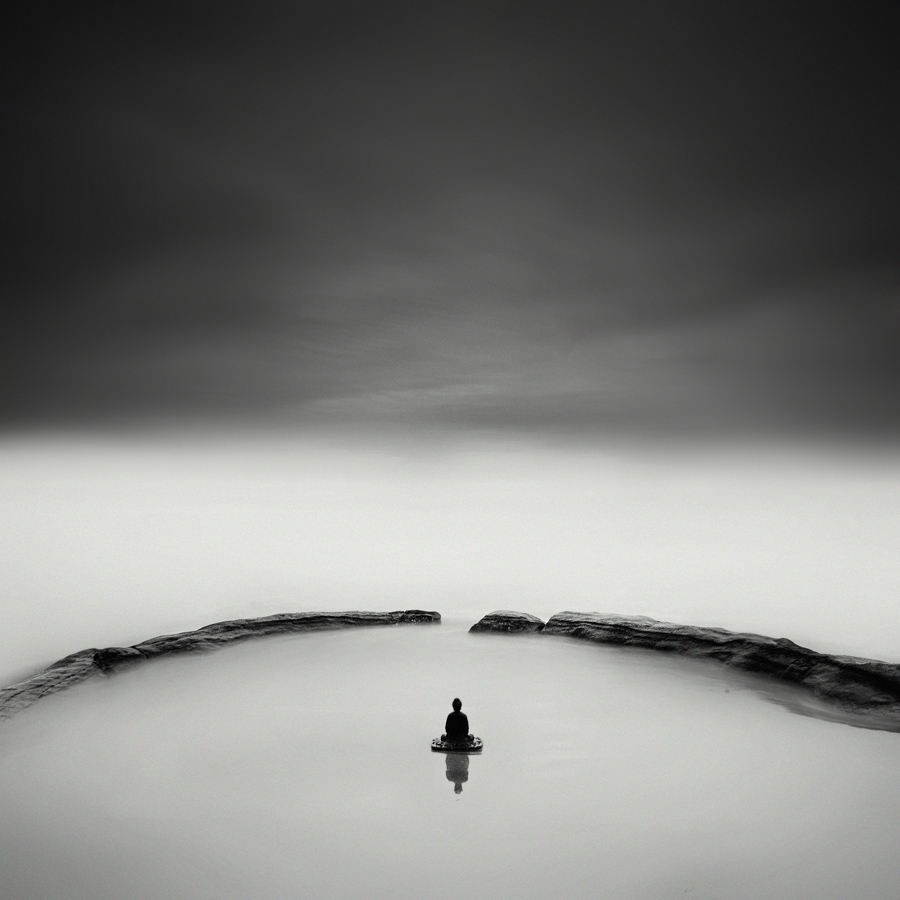Vision Drawings: Session IV – Nathan Wirth
Nathan Wirth’s minimalist style of black and white photography is reminiscent of zen perspectives and aesthetics. I often liken his images to a visual “echō” in photography (similar to the practice of drawing the ensō symbol) that lingers when the viewer feels the silence within themselves. Nathan’s photography is also a metaphorical form of calligraphy where the canvas symbolizes the transience of the artist’s solitude in creation, the strokes of the brush find fluidity in an imagination born of contemplative elements and silencing moments and the ink dries to reveal an impermanence of light and shadows in permanent arrest. Our own physical and psychological vision find sanctity in the silence of his poetic moments and our minds find their own meaning in his freedom of expression.
Nathan was kind enough to answer questions based on my own psychology of photography known as Vision Drawing (Oramagraphy) : A New Psychology of Photography: 6 Core Principles. I thoroughly enjoyed the back and forth experience and I can honestly say, after meeting, conversing and photographing with Nathan in San Francisco and beyond, that he is a gentle soul with a lot of wisdom.
I present to you, Nathan Wirth…
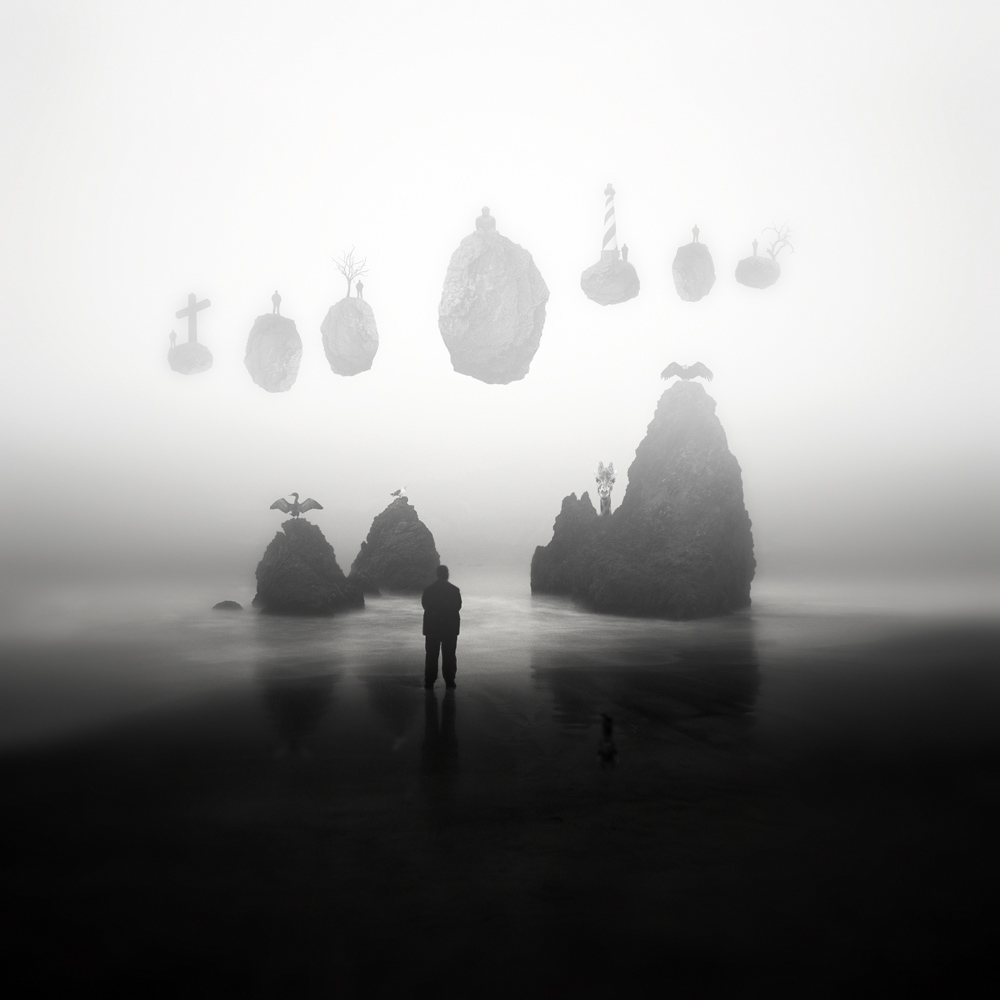
“A Series of Dreams – Dream Number 4”
Statement:
I am a self-learned photographer who uses a variety of techniques— including long exposure, infrared, compositing, and intentional camera movement— to express my unending wonder of the fundamental fact of existence. I do so by attempting to focus on the silence that we can sometimes perceive in between the incessant waves of sound that often dominate our perceptions of the world.
I earned both my Bachelor of Arts and Master of Arts in English Literature from San Francisco State University and bring a deep appreciation of poetry to my explorations of place (especially the ocean shoreline and the hills of the countryside). Poets such as George Oppen, Seamus Heaney, Robert Frost, Elizabeth Bishop, James Schuyler, Lorine Niedecker, and George Mackay Brown have played a fundamental role in shaping my attention to the things and places that I photograph. Often returning to the same locations many times, I explore through solitude the silence and the sublimity of those places. In addition to poetry, I am profoundly influenced by the paintings of Caspar David Friedrich, Edward Hopper, Mark Rothko, and Camille Pissarro and the photography of Michael Kenna, Edward Weston, and Wright Morris.
Recently, I have been studying and integrating into my work Japanese traditions of Zen, rock gardens, and calligraphy– as well as the transience, impermanence, and imperfections of wabi-sabi. My studies of calligraphy and Zen writings have led me to the practice of trying to achieve, while working on my images, a mind of no-mind (mu-shin no shin), a mind not preoccupied with emotions and thought, one that can, as freely as possible, simply create.
I also curate and edit slices of silence, an online place to read and view image-rich conversations about photography.
After living in San Francisco for the first 44 years of my life, I moved across the Golden Gate Bridge to Marin County. I currently make my living teaching English Composition at City College of San Francisco.
Q1. Prescience (Frame of Vision): Photographic vision is often considered an ambiguous but autobiographical notion, an ethereal but practical insight for the photographer into the invisible world made visible through a process of discovery (e.g., previsualization) and time in the darkroom (e.g., post-processing). When you consider this series of photos, how would you describe your own photographic process before, during and after you take the photograph and why you chose to make the photographs the way you did?
If I am being entirely honest, the term vision, and even the term artistic vision, has lost nearly all of its meaning for me over these past few months— in part, perhaps, because so many photographers have used this word to define and teach something which has always, for me, been unexplainable. I’d like to make it clear that in no way am I criticizing anyone for choosing to use the word in this way, nor am I trying to suggest that I have any special insight into these matters or that anyone should adapt or even entertain my views. I just simply don’t know where insight or creativity or discovery comes from, so, as a result, such terms have become increasingly irrelevant to me when it comes to discussing or trying to understand my own work. Vision— in the ways I am used to hearing artists talk about it and even how I have talked about it in the past— implies that one can intentionally learn and cultivate and follow some kind of artistic path. I most certainly cannot speak for others, but I don’t think that is what I have actually done over the years. I have simply photographed and processed images; whatever comes into existence as a result of my series of maneuvers is what comes into existence because I did whatever it is that I did … the work is the work … it can, in the end, be nothing else … and I arrived at it because of the experimental nature of how I have always conducted myself (one might draw a correlation with my mind altering experiments from my youth). I don’t pre-visualize anything. I simply encounter things. I stumble upon them. I have no exact plan. I am just grateful that such things happen when they happen— and I hope that they continue to happen.
As far as any sense of discovery goes, all I really have to draw from, on a concrete level, is a kind of well of madness that my creativity seems to be born from, a well of creative waters which lap back and forth and in and through my almost bipolar-like creative ups and downs— at times rising to an intense engagement with passing creative moments and then inevitably falling into the crippling self-criticism I typically place on my work—soon followed by those unavoidable periods of inactivity until I later feel a spark again. It’s a therapy-worthy kind of madness and none of those common Facebook memes about discovering and preserving and cultivating and expressing your creativity stand a chance in the face of those ups and downs. Fortunately, a spark always eventually ignites later on …
Yet, at the same time, I do have a lot of very specific things that I am pondering in my head— for example, my interest in finding and expressing moments of silence and solitude. Still, I am not exactly creating things specifically based on those various ideas. Such things are simply part of who I am. They are, thus, a part of my work … I guess I am saying that they come from and through those things … but not necessarily because of a specific and conscious attempt to express them (even though in the past this is how I have tried to explain them). The chances that anyone outside of me will ever notice those things, those sparks, is minimal at best, so, in the end, all I really have is what I have done and the hope that I will continue to happen upon things (and the hope that someone may wish to enjoy a few of my images).
I suppose the one very cognizant, intentional thing I have actively tried to do is gently nudge my ego to the side, not because I want to deny myself the personal pleasures and satisfactions of a successful image— or the kind words of acceptance that I sometimes receive from others— but because the experience of worrying about how an image will be perceived by others— and how such acceptance or lack of acceptance— used to often get in the way of my being able to do my work. I have spent some time studying the Japanese traditions of Zen, rock gardens, and calligraphy– as well as the transience, impermanence, and imperfections of wabi-sabi— and these various writings and mindsets have led me to the practice of trying to achieve, while working on images, a mind of no-mind (mu-shin no shin), a mind not preoccupied with emotions and thought, one that can, as freely as possible, simply create— an approach perhaps best represented by the seasoned calligrapher who seeks to brush, in a single stroke, the oval shape of the ensō. Completely removing the ego is, of course, difficult at best and nearly impossible for many, and I for one consistently fail to do so, but at least trying to remove it when I work has become important to me, and, as a result, I try to no longer focus on or worry about the during, the before, or the after of the process … I just photograph what I see in the way that I see it and then I try to process it as it flows.
All of that said— once again everything I photograph is in some way bound to a desire for silence and solitude. This does not necessarily mean that my photographs inherently express that or mean that … this is simply part of where they come from. I chose these images on this page because I think they are representative of that silence of solitude, that solitude of silence— whether one sees a lone figure in the distance or just the view that a lone figure once saw through his viewfinder. I rely on a few parlor tricks such as long exposure, infrared, compositing, and sometimes a combination of two or more of them—but all of these images are unified by my desire to find and experience that silence and solitude.
“Tree On A Hill”
In the end, I could have just said— I like to create images, so, therefore, I do.
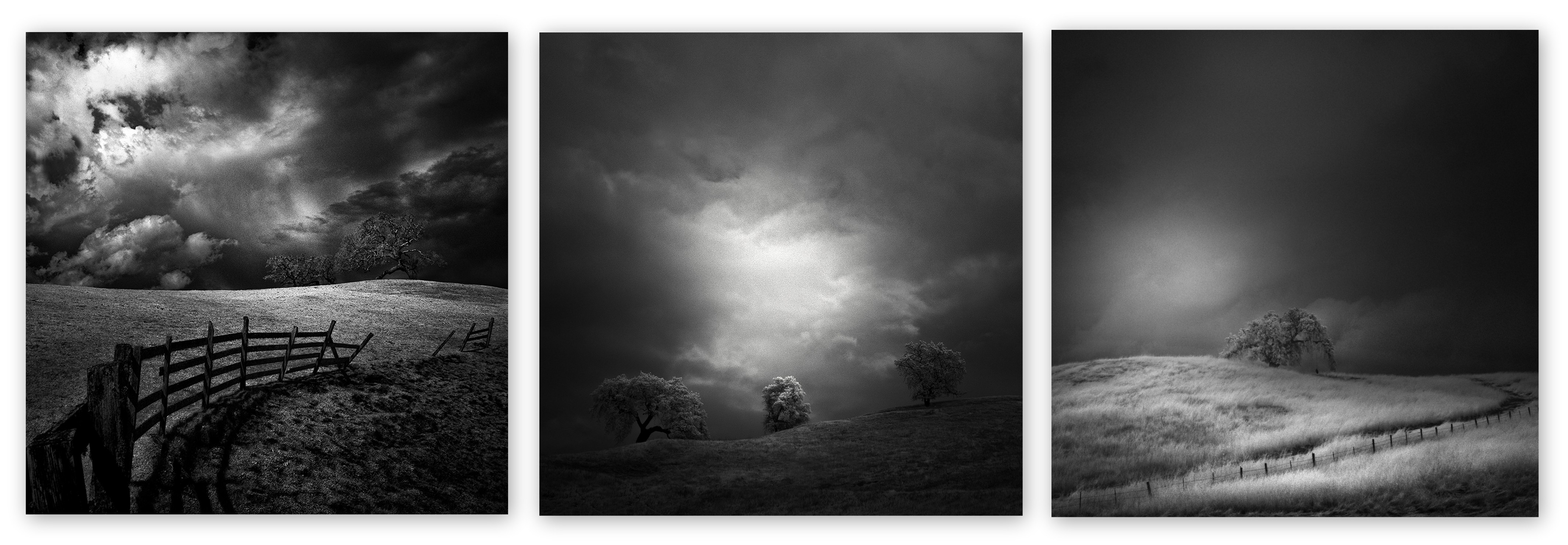 “Two Trees On A Hill – Study No.8” ~ “Hamilton III” ~ “Tire Swing”
“Two Trees On A Hill – Study No.8” ~ “Hamilton III” ~ “Tire Swing”
Q2. Paradox (Frame of Change): Photographers often strive for personal satisfaction first and originality second. However, each photographer offers a signature moment of personal originality that resonates with themselves and others as part of their development as artists. Is there a photo(s) that did that for you? What do you think your photos say about you as a photographer?
I used to think that I knew why I was taking photographs, but as I have continued to work on photos, I have realized more and more that I know less and less about such things, and most wonderfully, that I really don’t need to know. All I really need to do is work on stuff (and, truthfully, I don’t even need to do that). I got wherever it is that I am today by simply working and experimenting so that I could see what might yield what (though I most certainly worried about a variety of unnecessary things along the way). When I first started making images, I was guided by a curious mix of (a) my confusion about what I was doing, (b) my need to be accepted by my peers, and (c) my technical limitations and lack of knowledge. Over the past seven years, I have become (a) less confused about what I am doing, (b) far less concerned about how others receive my images, and (c) less worried about the technical perfection of my work. C is, perhaps, why I never garner any real significant attention from any of the competitions I have entered. I suppose, in the end, I am not really a very good technical photographer (or even a photographer at all, especially considering my preoccupations with all of the parlor tricks— such as long exposure, infrared, and compositing— that I utilize). I always smile with a healthy dose of guilt whenever anyone suggests that I have mastered something— but, hopefully, I am at least a reasonably expressive image maker.
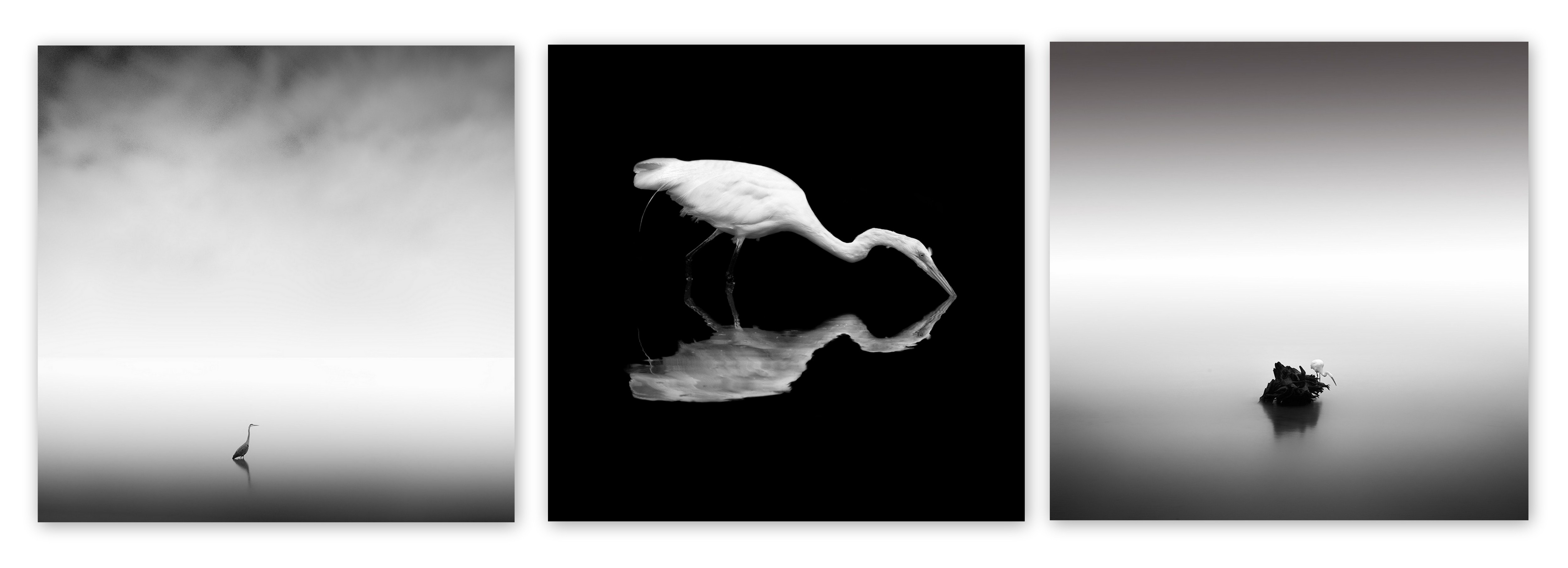 “Heron 3” ~ “Symmetry Revisited” ~ “Silent”
“Heron 3” ~ “Symmetry Revisited” ~ “Silent”
I suppose the first real significant turning point in my work began when I embraced simplicity or, as many refer to such things, minimalism. My first real output of such was a very, for lack of a better word, simple and minimal image of an egret and its reflection trying to catch a fish. I hesitate to say exactly how I processed the image (there is nothing difficult, original, or admirable about the processing) because I know that there are many out there who will jump in and tell me the more effective and proper ways that I should have known about and used (and how I wasted my time using the approach that I did), but, again, I am, in many ways a lousy photographer and processer on the technical side of things (and I don’t care how I get to my results; I only care that I eventually get there). Please permit me to digress a bit and let me say that I suppose such critics would be correct from a technical perspective, but … really … what real difference does it make how I achieve what I achieve? Doesn’t the final image matter far more? When looking at the work of others— other than curiosity and perhaps a desire to learn new techniques— what does knowing the process behind the making of an image really have to do with viewing and appreciating the image? I don’t look at Mapplethorpe’s flowers and worry about his camera and lens choice or what lighting he used. I don’t look at a decisive moment captured by Bresson and wonder how many indecisive moments he captured before finding the decisive one. I don’t even look at Ansel Adams’ work and worry about his zone system. I simply appreciate the photo—and often without feeling any compelling need to explain why I appreciate it (though I certainly could if I had to). The images that I connect with the most deeply are always experienced emotionally and silently. I suppose that I like to appreciate an image in and through the same silence that I seek while working on my own work. And, by extension, I hope that maybe one or two of my images might meet one or two people who simply appreciate the image (and please note that my concerns are not based in whether anyone appreciates me). Digression over …
I don’t, however, know if this photo reflects any personal or signature originality; in fact, I don’t know if anything I have done represents any originality. I do think that I have likely strayed as far as possible from copying other people’s styles. I absolutely love Michael Kenna’s work, but I do not think I have copied him in any way (though his influence is undeniable and impossible for me to entirely avoid because of how much I admire his work). I do know that I can’t copy Kenna’s style— or the style of any of the well-known photographers working in long exposure— because of the limitations of my technical savviness (nor do I read about how others process their images). My processes— as slow, as amateurish and as faulty as they may be— are my own and were discovered by me alone.
A few kind souls have told me that my work looks very much like my work, but, again— and sorry about all of these moments of confession— I cannot with any real honesty say whether or not I have a particular look or feel to my images. I suppose they are fairly moody, but silence and solitude, in general, can be quite moody, so perhaps I am on some level somewhat successful in that area.
So, what do I think my photos say about me as a photographer? Gosh, I worry that they reflect a potentially unhealthy obsession with rocks, trees, and my potentially egocentric need to feature myself standing in the middle of stuff, but, in the end, I will have to dust off the old cliché that once I am done with a photo it is no longer mine and such matters are left up to the whims and fancies of those looking at the images. I also worry that someone will discover my almost bipolar roller coaster ride of satisfaction and dissatisfaction with my work (which profoundly contradicts my attempt to remove my ego when I process my images). Your next question addresses such things more specifically, so I will wait to say more then.
“Marshall Beach” ~ “Bandon” ~ “Deux”
Q3. Parallels (Frame of Relations): The elements of a photograph come together in harmony to communicate an admiration of a subject, to provide an interpretable story in a stilled moment, and foster a relationship between the photographer and the viewers. Although we often want the viewer to provide their own insights into our photographs, what do you think people notice the most about your work (e.g., an underlying theme) and why?
I could very easily just say— “Gosh, I do not know”— and then move on to the next question, but I shall endeavor to provide something more specific. The funny thing to me is that so much of my thinking (philosophical and poetic) leaks into a photograph whether I want it to or not, but, in the end, nobody has any idea that I was thinking about such things. I sometimes even offer a few words about what I was thinking, but there is no guarantee that anyone will even read what I said, and I often hear people tell me that I am wrong, that my image is about what they say it is about. Meaning is, after all, subjective and entirely and unavoidably ambiguous at best.
When asked questions such as this, I often trail off into explanations about my poetry studies from graduate school, into such fundamental beliefs and approaches that anything symbolic or metaphorical is first and foremost grounded in the actual thing itself, a fact of the actual that many forget to embrace as they jump into the world of what they think something means. In other words, many try to figure out what something might mean or represent without making sure that they fully understand, first and foremost, what the something actually is. An image is always fundamentally bound to whatever the image is an image of … and if one wishes to interpret something from it, infer something beyond it, then one should ground such inferences in the things found in the image itself (personally, I think this is true of all the arts). I know all too well that my thoughts about my own images are lost as soon as I let the photo go … I do hope, however, that some people can— through the minimal and simple things I photograph— feel the silence that I tried to encounter in the moments I first captured the image.
Many people look at my self portraits and think I must be lonely– which is so far from the truth. I am not lonely at all. In fact, I am very happily married and have been so for nearly twenty years. I also have a lovely eight-year-old daughter. I have some very good friends. I am also very content when I am by myself— with only the silent chatter of my thoughts reeling away in my head. I don’t say these things to suggest I am this happy-go-lucky positive “everything-is-beautiful-you-just-have-to-learn-how-to-look-at-things-in-right-kind-of-way” person either. I am often cynical and tired and cranky and often waist-deep in a variety of unnecessary and annoying existential crises (I don’t, for example, see the proverbial cup as half full or half empty; I just see a cup with some liquid in it), but this to me is all part of being human. For me, my self portraits reflect a very Emersonian wonder for the existence of things and so do, for the most part, all of my images of rocks and trees. I am fascinated that anything even exists at all— that there is some sense of an experience of a past and a here and now and a future — and I crave the solitude necessary to ponder such things. But such things even if were to explain them are very unlikely to be picked up by viewers of my work.
I think, in the end, this has much to do with the fact we tend to project our own desires, worries, and ideas onto the images that we encounter. Many will look at an image of mine and think— “why bother to take the time to photograph a dumb rock?”— and then move on. Others might, hopefully, like the tone and contrasts and maybe even the mood and then drop the good-old proverbial, yet surprisingly meaningless, “nice” and then move on. Some might think I am some warm, mystical New Age artisan that exudes spiritual light and comforting smiles wherever he goes (I am, of course, most certainly not). Others might just appreciate the way I composed the sea, a rock, or a tree— and then how I infused light into the image. Others won’t stop to look at all. And for those who do stop, their experience will all depend on how they perceive the things in their own lives. If they associate solitude with loneliness, then they will likely experience their own feelings about loneliness in my images; if they associate solitude with contemplation, then they might lose themselves in a few seconds of contemplation.
But what do I wish them to see? That would make an interesting question. I often dream that they will feel the same moments of solitude and silence that I yearn for.

“Self & Rock I & II” ~ “Self & Daughter”
Q4. Perception (Frame of Reference): You have probably heard the adage about there being as many realities as there are people but there is one thing that seems to be quite universal: the sense of wonderment about the beauty we find and capture in moments and the emotion that encapsulates it all. I am fond of saying that the complexity of beauty gives the artist a beautiful complex. How and why has photography changed the way you sense and perceive the world?
This is an interesting question and one that I am not certain I have an answer for. I guess my answer would depend on whether by seeing and perceiving you purely mean how I literally see it through my eyes’ physical abilities to discern shapes and colors, etc or, instead, how I figuratively understand and imagine the world. I suppose creating images has changed how I frame and / or compose the world visually. In other words, I often see my surroundings through the frame of a square composition whether I have a camera or not. I also notice things that maybe in the past I did not notice as easily. When driving through the countryside, for example, I can’t help but sneak a peek for a compelling tree or group of trees, or when driving by the sea an interesting rock formation. I also pay much more attention to the weather. But I think my studies of literature (especially poetry), paintings, the cinema, Zen, and Western philosophy have had a much more profound influence on how I perceive the world. Those studies have often been much more associated with my rational and irrational understandings of how I perceive existence and my perceptions of the things in it. Photography, for me, is much more of a visceral experience, one that can be both complemented and complicated by my intellectual pursuits, but still an experience that primarily frames what I encounter rather than what I am specifically looking for or how I see, sense, or perceive things.
“Wake – Richard Serra”
Q5. Personality (Frame of Mind): If you had to describe yourself as a photographer using three distinct words, what would they be and why? Are there hints in these photographs that speak to your individuality or essence as a photographer?
Solitude and silence. I know that the coordinating conjunction and does not necessarily count as a distinct word, but my main attraction to photography is finding solitude and silence. More often than not, when taking images I try to be as absolutely alone as I can so that I can hear that silence in the rolling and crashing of waves, the hum of the wind, and the various sounds of the birds and / or insects that share the landscape or seascape with me (I am thinking of Thoreau’s many companions from his musings on solitude in Walden). The and insists that these two words be considered together – whether they are synonymous or similar or even different (all of those possibilities are relevant to me)
On a side note, I do, from time to time, hang out with others, and I even once planned and organized a three day photowalk (which surprised those who know me well), but I rarely find or encounter images during those times because my attention is preoccupied with talking to others, and, consequently, the little details of the world around me slip on by unnoticed.
I can say that silence and solitude are part of my experience of seeing, really seeing. In order to better understand what I am talking about. One might refer to Annie Dillard’s Pilgrim at Tinker Creek:
“The answer must be, I think, that beauty and grace are performed whether or not we will or sense them. The least we can do is try to be there.”
or Mary Oliver’s poetry and essays:
“To pay attention, this is our endless and proper work.”
But I don’t want to confuse this with seeing in order to find something, to find, for example, that perfect composition. I don’t tend to walk around for a long time and study every single angle. Either I encounter it or I don’t. But in order for me to be receptive to such possibilities– I need, I crave, that silence and that solitude.
As far as my essence and individuality, I have no idea. Such questions are probably better left for someone probing my insecurities while I rest on a couch in his or her office. All I know is that I have been generating photographs for seven years now (many of which, I have to confess, have been very shitty … though I am getting better at it), and that I seem to be continuing to do so. That said— I do secretly hope that after I have died, someone might encounter an image of mine and connect with its potential to express silence and solitude.
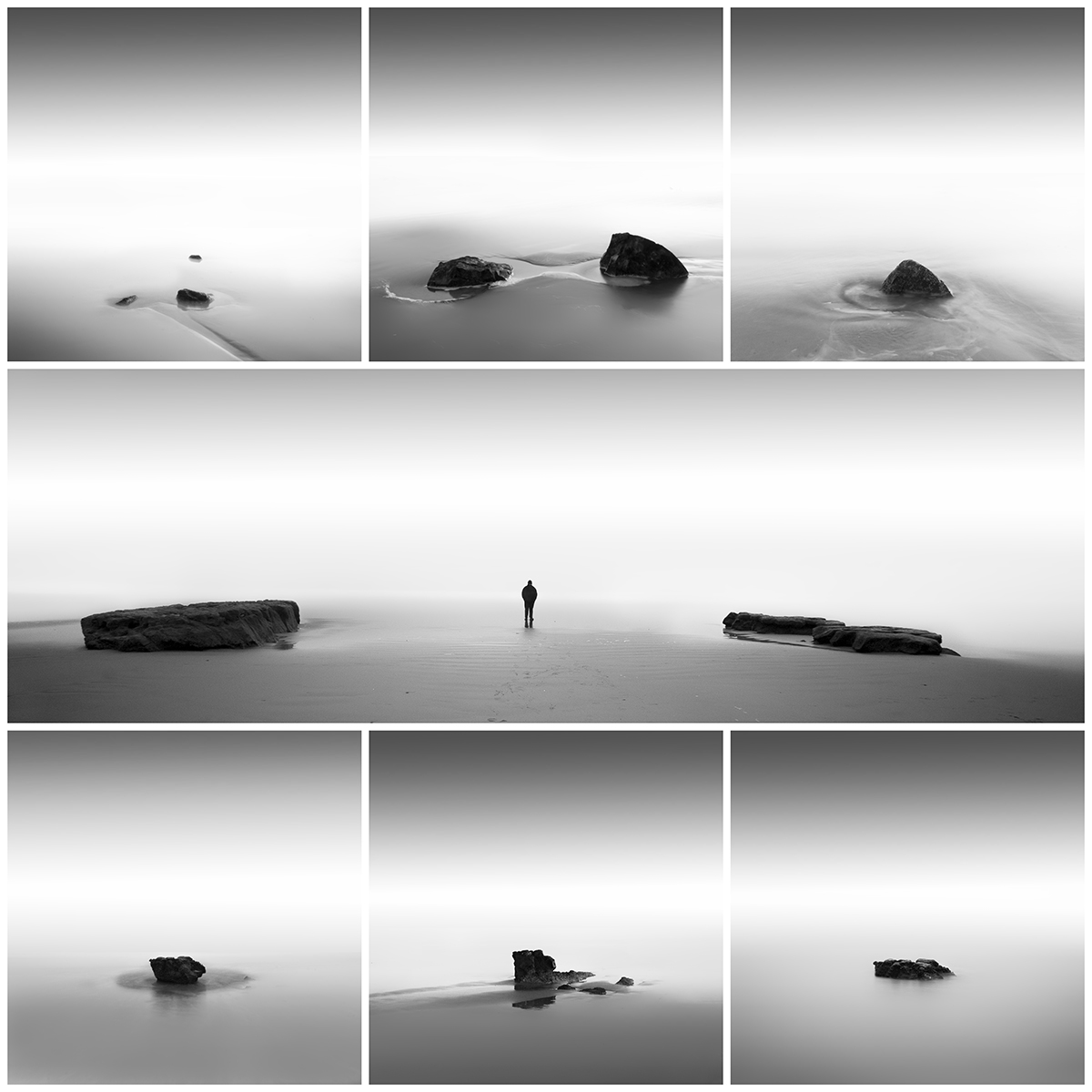
“Things Encountered”
Q6. Progression (Frame of Time): Although the “what inspires you” question is tried and true, I want to ask it in a different way: what do you think will inspire people about you and your photography in a few years time and why? Is there any advice that you would give fellow photographers about things they need to do to gain confidence or avoid on the road to self-fulfillment as artists that you wish you knew years ago?
I’ll start with the advice. Don’t listen to anything that I have to say. For the sake of those that have read this far down, this should probably have been the first question so that they could have avoided all of my previous ramblings. A lot of photographers offer advice. There are tons of blogs about what you should do and what you should avoid doing (for example, “The Top Ten Top Things That Top the List of Top Things That You Must Do In Order To Be A Top Photographer”). I don’t personally think any of it is very helpful, most of it being overly obvious things that most people know but forget about when they are nervously and anxiously preoccupied with finding ways to be discovered so that they can eventually turn their photo hobby into a profitable business. And if we are being honest, much of this advice is geared towards getting people to visit the blog and click on the ads so that the advice givers can make a profit off people’s visits.
While I am not willing to offer any advice of my own, I will offer the advice of another person, the great German poet Rainier Maria Rilke. In 1903, a young poet began writing Rilke a series of letters asking him to critique some poems and offer guidance. Rilke wrote the following to the young poet:
You ask whether your verses are any good. You ask me. You have asked others before this. You send them to magazines. You compare them with other poems, and you are upset when certain editors reject your work. Now (since you have said you want my advice) I beg you to stop doing that sort of thing. You are looking outside, and that is what you should most avoid right now. No one can advise or help you – no one. There is only one thing you should do. Go into yourself. Find out the reason that commands you to write; see whether it has spread its roots into the very depths of your heart; confess to yourself whether you would have to die if you were forbidden to write. This most of all: ask yourself in the most silent hour of your night: must I write? Dig into yourself for a deep answer. And if this answer rings out in assent, if you meet this solemn question with a strong, simple “I must”, then build your life in accordance with this necessity; your whole life, even into its humblest and most indifferent hour, must become a sign and witness to this impulse.
(Here is a link to the rest of this first letter, which will lead you to the rest of the exchanges between Rilke and the young poet or just by the book and keep it on your bookshelf :).
Please note that Rilke’s words are for those who are interested in a life as an artist. His words will provide no real tangible wisdom for those that are only trying to make money (though I am sure the savviest influencers and marketers out there can easily figure out a way to turn a profit off these words anyway). In fact, if making money off your work is your main goal, then you should run away from me even faster because my absolutely lame and damaging approach to making money off my work might well infect you and potentially destroy your chances for a profitable life as a photographer. I am the kind of idiot who has given away far more images than he has sold, the kind of idiot who has licensed images to musicians for free because he admired the work of the musician.
“Minimalism – Study X”
I just can’t possibly come up with anything for what I think will inspire people about me or my work—especially since such a question implies that (a) anyone will actually care about my photography in the future and (b) anyone even cares about it now. I am beyond grateful anytime anyone takes the time to breeze past one of my images and stop long enough to indicate that they saw it. I truly mean that— especially since we live in a world saturated with imagery. But, in all honesty, I have no real way of knowing whether anyone is actually inspired by my work. I don’t say this to be self-deprecating or ironic or cranky or critical of the generosity of those who take the time to visit one of my images. I just don’t really know. I look at my own images and think that some of them are pretty good, but I spend far more of my time on creating them, and, in the spirit of continuing honesty, I don’t exactly know why I even create and share them in the first place (other than that ego-driven well of madness that I explained earlier in the interview). At first, it was most definitely the allure of attention and the hopes that I would be successful at it, but as time has passed, I might well have deluded myself with visions that I could be an artist and maybe that is, in part, the mindset that I now work from.
But what exactly is success anyway? Well, going back to the whole advice thing, there are a dizzying number of blogs that claim to offer the path, the tools, the stuff that you need to be successful (“The Top Ten Top Things You Need to Achieve the Top of Top Success Right Now”), but precious few of these blog entries ever really take the time to define what success actually is (other than an assumed financial and ego-centered profitability). Is it making money off your work? Is it getting a gallery to represent your work? Is it winning awards in competitions? Is it being published in a magazine? Is it having a photo selected by 1X.com (who, by the way, have soundly rejected me)? Is it making the front page of 500px? Is it achieving the admiration of many, many people? Is it finding personal satisfaction in what you do? Is it finally figuring out how to do something that you couldn’t figure out how to do before? Is it finding some quiet time away from your hectic life to focus on something that brings you satisfaction? Is it simply just being able to continue to create? Is it a combination of these things? Is it an ever evolving combination of things? I can hear many out there mumbling to themselves as they read this that the answer depends on you and what you want. And, at first, that does sound quite wonderful, and might well be the best possible answer, but why then are so many people dissatisfied and lost when trying to figure out what they are doing with their photography, when grappling with whether their work matters or not (even when they announce on public media that they are amazed by their own work and experiences)? And why then do so many people feel dissatisfied even when they achieve these things (especially many of those people who constantly announce how happy they are as they achieve these things)? I can hear the silent screams of many out there announcing, with fists raised high, “I photograph for myself and no one else”! But if that is the case then why show your photos to anyone other than those who are closest to you? Vivian Maier photographed for herself, but do the rest of us who share our work on various platforms really photograph just for ourselves? I can feel that others are now currently grabbing their links to Facebook memes that lay out the principles of creativity and success, the self-help cries of the humanity and growth of expressing yourself through art, the declarations of how important it is to love oneself before others: but does any of this really define success (or, in the end, help us to understand success beyond a few over generalized thoughts)? I don’t pretend to know such answers … nor do I wish to criticize or judge anyone’s feelings, thoughts, or beliefs about such things. What, after all, do I really know about any of this?

“I”
Still, what is the answer to all of this? What is success? I may be a fool to bother to ask all of these questions, but I am not such a total fool that I will pretend that I can offer an answer. Perhaps there is no real answer … perhaps all we have is our neuroses and our drive to do our work … our half-baked notions of what it is and our curious need to attain it. Perhaps that is enough. I do know that when I first set out to do photography, I worried about none of these things. It was only when a few small “successes” started to happen that I began to worry about it. And such concerns continually wreak havoc on my already rocky rollercoaster ride through my bi-polar-like highs and lows— even as I attempt and fail and succeed and fail to gently nudge my ego aside and just work on my photos.
It is most certainly a lovely notion to think that someone might be inspired by my images, but I can’t possibly guess what that inspiration would be grounded in now or later. I believe that much of the Western art world has been buried, for a while now, in the notion that life has no real tangible meaning and, therefore, art itself cannot possibly have any meaning, all of that suggesting that, at best, art is little more than an ironic reflection on its own creative processes. I’d like to think that my work currently stands, and will continue to stand, in opposition to an art world preoccupied with silly notions of irony for the sake of irony, notions that art is little more than artifice, little more than a mockery of itself and, by extension, a mockery of anyone who would waste his or her time trying to express his or her work from the creative mindset that our lives can (and should) be guided by a pursuit of meaning (even if, in the end, no one can prove or even really successfully define such things). I soundly reject such an absurdist outlook and embrace, instead, the wonder and amazement that we even exist at all and the possible labyrinths of meaning that one can pursue down such twists and turns.
Firmly grounded in my thoughts about my favorite poet George Oppen, the real question, the real mystery, is not, for me, who we are but the fact that anything even exists at all. Such thoughts provide me with an unending font of possibilities to draw from … and such wonder and pursuits of the possibilities of meaningfulness are infused into every image that I take (though, again, this is not necessarily what my photos represent or mean). Whether anyone currently recognizes such things in my work or even gives a shit about such things (or whether anyone will ever care) is something I can never have any answer to. I will, however, likely continue to pursue and consider such things until my final breaths of life.
“Hamilton I”
Q7. What one insight did you gain about yourself as a photographer after going through these questions?
I think I already knew that I am a cranky, self-conscious, excessively wordy image maker who enjoys the often frustrating yet exciting world of creating images— especially the moments of solitude and silence that it provides— but I think I have now offered ample evidence for that assessment! I’d like to officially clarify that I no longer think of myself as a photographer— and I am too wise and self-aware of my many limitations to think I am an artist (though I would secretly like to be known as one anyway). I’m not sure where that leaves me. Perhaps I can be known as a dude that makes stuff.
I’d like to thank you, John, for inviting me to take part in this interview, and, at the same time, I’d also like to apologize to you and anyone who made it this far in the interview. My images might often be very minimal, but my words and thoughts rarely are!
“Buddha & Clouds”
Websites
~ Flickr
~ Slices Of Silce: Conversations About Photography
All Images © Nathan Wirth

